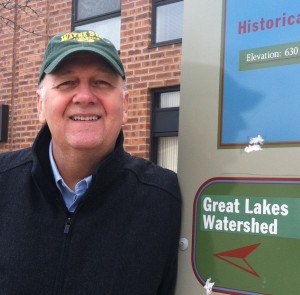
Gary Wilson
Commentary
Did you ever go to a dull party?
Sure, it was a party in name and it had all the components of a party but it was flat. It followed a script and the host was on autopilot. All the bases were touched but there was no spontaneity.
There was nothing incorrect about the party but also nothing to inspire.
That was the Asian Carp public hearing in Chicago this week.
Asian carp team comes to ground zero… Chicago
The Obama administration’s Asian carp response team came to town this week to update the public on how it’s stopping the advance of the voracious fish that threaten the Great Lakes.
The White House’s John Goss directs the group, officially known as the Asian Carp Regional Coordinating Committee, and he led the 90 minute presentation with efficiency and aplomb.
The meeting started exactly on time with Goss giving an update on accomplishments and goals of the group. “We’re working to not have an established (Asian carp) population in the Great Lakes” Goss said. He continued that the electrical barriers have been “enhanced and they are more powerful.”
Good information but isn’t that what we’d expect?
Then he turned it over to multiple speakers, all with an area of expertise, and they went through their slides and talking points.
First were Charlie Wooley of the U.S Fish and Wildlife Service and John Rogner from the Illinois DNR. They complemented each other like a shortstop and second baseman who had been turning double plays for a decade.
Wooley talked about the number (seven) of rapid responses they’ve conducted that didn’t yield any Asian carp. Accomplishment and success, check.
Rogner had more stats saying that 24,000 carp had been removed from the waterways so far this year. Accomplishment, check. Wooley closed saying that they had a supply of fish poison at the ready just in case it was needed and showed a picture of it as proof. Readiness, check.
Very efficient and correct. People love data. It makes the complex easier to understand.
Then came the Army Corps of Engineers’ Chicago area commander Col. Frederick Drummond.
Drummond projects the military demeanor that makes you want him on your side. There was no shyness on Drummond’s part as he said that the “electrical barriers are absolutely effective.”
Interesting as I don’t hear others with expertise talk about the electrical barriers in “absolute” terms.
To his credit, Drummond got in front of a potential question about a recent power outage that shut the barrier down. He said they used it to better prepare for the next outage. He backed the statement with data and closed saying no carp moved past the barriers during the outage.
For all of his confidence, Drummond had a slight dodge when asked about the recently passed law that requires the Army Corps to produce the physical separation study in 18 months versus five years. “We’re evaluating it” Drummond responded as if he had no prior knowledge of the law despite the fact that it has been pending for two years.
The White House’s Goss closed with an impressive chart illustrating that the administration has spent $150 million to battle Asian carp since 2010. He glossed over the fact that a good portion of that money came from the Great Lakes Restoration Initiative which was not appropriated to fight carp.
That was it.
Very precise, comprehensive — lots of charts and a ton of data — and all the speakers stayed on message and reinforced each other. Presentations started and ended on time and that was noted as if it somehow contributed to stopping the carp.
The only technical flaw in the show was a presentation by an executive of Chicago’s Shedd Aquarium. It had all the markings of an infomercial and detracted from the presentations of others. Why was it there except to promote the Shedd?
I was expecting a large turnout for the event — it’s not every week that the White House sends it’s “A” team to town — but not the case. The approximate 30 attendees had few questions and none of them were tough or probing. Interested parties who called in to the meeting were not allowed to ask questions.
I asked what the team’s response would be if they found a substantial number of carp past the electrical barrier. The Illinois DNR’s John Rogner didn’t miss a beat and quickly referred me to their website.
The plan is there ready to go. Apparently there was no need to talk about unknowns, strengths and weaknesses.
Open the book and follow the plan. If only nature worked that way.
The “friendly confines”
Chicago is a friendly venue for an Asian carp government presentation. It would be among the least impacted locales if the carp were to be established in the Great Lakes.
I can almost guarantee that this by the book presentation would have been met with tough questions and perhaps outrage if made in Cleveland as evidenced by the editors of the Cleveland Plain Dealer who have called the electrical barrier “flimsy” and said the Army Corps is “clueless.” Lake Erie has the largest fishery in the Great Lakes and therefore the most to lose if an Asian carp invasion is successful.
If you were new to the Asian carp issue and came to the presentation by the Obama administration’s John Goss and his crew you’d probably be impressed.
Even a jaded veteran like myself had to admit that a ton of executive expertise and resources have been brought to bear to keep carp out of the Great Lakes. And Goss has no easy job in leading a group of disparate agency types and an Army officer to boot.
But it’s late in the battle against Asian carp.
I hope Goss has the authority and courage to deviate from the script if events warrant. That’s what good leaders do.
Because no one likes a dull party.
Or Asian carp in the Great Lakes.
